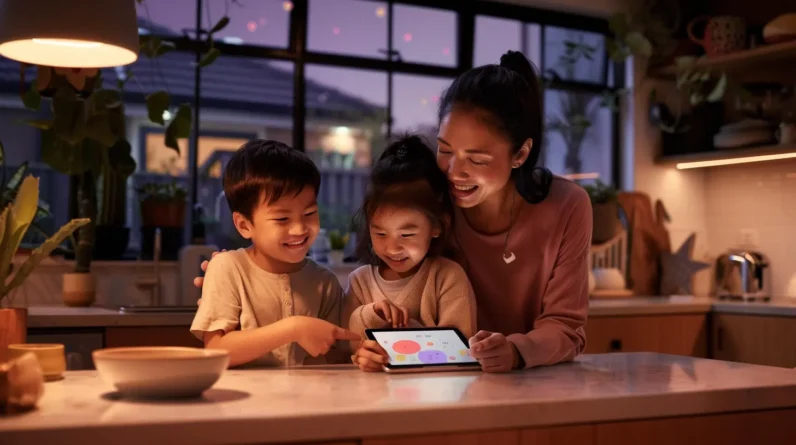
We can transform our homes into dynamic learning environments by strategically integrating educational apps within smart family ecosystems. Through centralized platforms like Google Family Link or Apple Family Sharing, we’ll synchronize devices, establish personalized user profiles, and implement robust parental controls. We’ll leverage cloud-based solutions to track educational progress across devices while maintaining age-appropriate boundaries and content filters. By analyzing performance data and utilizing cross-platform compatibility, we’ll create a seamless learning experience that adapts to each family member’s needs. The path to building an effective digital learning hub begins with understanding these key integration components.
Creating Your Digital Learning Hub
Setting up a digital learning hub requires strategic planning and clear organization to support your family’s educational goals. We’ll start by selecting a centralized platform that can sync across multiple devices while maintaining robust parental controls. Popular options include Google Family Link, Apple’s Family Sharing, or dedicated educational platforms like ClassDojo.
Next, we’ll categorize your educational apps by subject area, age group, and learning objectives. Create separate user profiles for each family member to track individual progress and customize content delivery. We recommend implementing a scheduling system that balances screen time with other activities, using built-in tools to set time limits and monitor usage patterns. Don’t forget to establish clear protocols for data backup, app updates, and security measures to protect your family’s digital learning environment.
Smart Device Synchronization
Today’s interconnected educational environment demands seamless integration across multiple devices, and we’ll show you how to achieve this through smart device synchronization.
We’ll start by configuring your primary device as the hub, typically a parent’s smartphone or tablet, then linking additional family devices through your chosen platform (iOS Family Sharing or Google Family Link). Essential steps include setting up shared cloud storage, enabling cross-device notifications, and establishing user profiles for each family member.
For peak educational app synchronization, we’ll configure automatic data backup, enable progress tracking across devices, and set up shared calendars for learning schedules. Remember to activate content syncing for educational materials and customize sharing permissions for each family member’s device. This guarantees seamless shifts between devices while maintaining individual learning progress and privacy settings.
Family Access Controls
Once educational apps are synchronized across devices, implementing robust family access controls becomes essential for maintaining a safe and structured learning environment. We need to configure appropriate restrictions through built-in parental controls and app-specific settings to manage children’s screen time, content access, and in-app purchases.
Let’s establish separate user profiles for each family member, setting age-appropriate boundaries and learning goals. We’ll activate content filters to block inappropriate material while enabling educational features that align with our children’s curriculum. Through time management tools, we can schedule dedicated learning periods and prevent unauthorized access during homework or bedtime hours. By using monitoring dashboards, we’ll track app usage patterns and learning progress, allowing us to adjust permissions and educational content based on each child’s development and needs.
Educational Progress Analytics
Through thorough data analysis, educational progress analytics provide families with actionable insights into their children’s learning trajectories. We can track key performance indicators across subjects, identifying areas where children excel or need additional support. These analytics help us pinpoint specific learning gaps and recommend targeted interventions.
We’ll leverage data visualization tools to present progress reports that highlight patterns in learning behaviors, completion rates, and subject mastery levels. By monitoring time spent on different activities and success rates in various challenges, we’re able to adjust difficulty levels automatically and suggest personalized learning paths. The analytics also enable us to compare progress against grade-level benchmarks while maintaining individual learning preferences. This data-driven approach guarantees we’re making informed decisions about each child’s educational journey.
Cross-Platform Learning Solutions
Modern families need educational apps that work seamlessly across multiple devices and operating systems. We’ve found that cross-platform compatibility guarantees continuous learning whether children use tablets at home, computers at school, or smartphones on the go.
To maximize learning effectiveness, we must prioritize solutions that sync progress across iOS, Android, Windows, and macOS platforms. Let’s focus on apps utilizing cloud-based architectures that store user data centrally, enabling real-time updates across all devices. We’re seeing success with HTML5-based applications that maintain consistent functionality regardless of platform choice.
The key is selecting apps with responsive design principles that automatically adjust to different screen sizes and input methods. This approach guarantees that learning activities remain engaging and accessible, whether students are typing on keyboards or using touch interfaces.
Conclusion
We’ve explored how integrating educational apps within smart family ecosystems can transform home learning environments. With 78% of families now using multiple connected devices for education, it’s critical to implement synchronized learning platforms effectively. By following our framework for device integration, access management, and progress tracking, we’ll create a seamless educational experience that adapts to each family member’s needs while maintaining security and educational focus.







